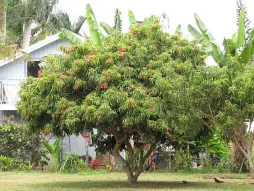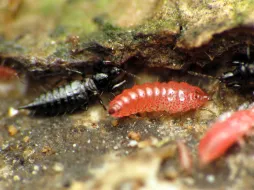Dimocarpus longan, the dragon-eyed tree
Some people have the eye of the tiger, but Dimocarpus longan has the eye of the dragon. This tree of the Sapindaceae family grows wild in China and India. It is prized for its sweet fruit and large crown of leaves.
How to recognize the longan tree, Dimocarpus longan?
The longan (Dimocarpus longan) is a tree with a spreading, rounded habit. It can exceed twenty meters in height when grown in the ground.
Its branched trunk can reach a meter in diameter. Its bark is light brown and cracked. The cylindrical branches bear lenticels and brown hairs.
Dimocarpus longan has evergreen foliage. The alternate, pinnate leaves are composed of ten to twelve elliptical leaflets. They measure up to twelve centimetres long and five centimetres wide. Young shoots are burgundy in color. They turn dark green and glossy when mature.
The longanier blooms in spring or summer. They are adorned with fragrant, melliferous yellow flowers. They are grouped in panicles at the end of the branches.
The fruits, called longans or dragon's eyes, also appear in groups. Some clusters can have as many as 30! They are spheres two centimetres in diameter, with a thin, hard skin. Yellow or brown, the shell is covered with spikes and encloses a brown seed and translucent flesh. Its sweet flavor and juicy texture are reminiscent of Litchi chinensis fruit.
The fruit is edible, but the seeds are slightly toxic to dogs and cats. Make sure your pets don't swallow them!
Our maintenance tips
Watering
When the soil has dried on the surface, you can water. Use non-calcareous water at room temperature, such as rainwater. If you don't have any, you can use tap water that you've left to stand.
Drain off any water that collects in the planter or dish. It can rot the roots.
Spray
Mist the foliage with non-calcareous water at room temperature. This will increase humidity and limit pest attacks.
Repotting
In spring, transfer your Dimocarpus longan to a larger pot, so that it can continue to grow.
When your Longanier is cramped, you can repot it. Choose a larger pot with holes.
Fill the bottom with a slightly acidic, draining substrate, such as potting soil for citrus or Mediterranean plants. Plant your specimen in the center and add substrate. The root ball should be a few centimetres below the pot to leave room for watering.
Water copiously to facilitate rooting and remove air bubbles.
Fertilization
You can stimulate the growth of your plant during its growth phase, in spring and summer, with fertilizer.
Place compost at the foot of your Longanier.
You can stimulate the development of your plant during its growth phase, in spring and summer, with fertilizer.
Longaniers are greedy plants. They need to be fertilized. Feed yours with a special liquid or granulated citrus fertilizer.
Prune
To encourage the growth of your Longanier, prune regularly.
Remove dry leaves. They exhaust the plant and slow its growth. If you use an instrument (pruning shears, scissors), make sure it's clean.
Plantation
Once the last spring frosts have passed, you can plant.
Choose a sunny, sheltered and isolated location. The first trees or your house should be at least four meters away.
Soak your Longanier. Dig a planting hole twice as wide as the root ball. Plant your Longanier. The surface of the rootball should be level with the ground.
Fill in the hole with garden soil. You can add compost or manure to enrich the soil.
Tamp to remove air bubbles and water to help the plant take root.
Seedling
Your seedlings need warmth. Summer is the best time to get started.
Remove the pulp from around the stone and leave to soak in water for 24 hours.
Line the bottom of a transparent box with a damp paper towel. Place your kernel inside and cover it with another sheet of damp paper towel. Close the box.
Wait two to three weeks for the kernel to germinate.
Fill pierced plastic cups with a mixture of potting soil and sand Plant your Longanier. The root should be at the bottom and the sprout at the top. Cover the core and root with a thin layer of soil and leave the sprout in the open air.
Place your plant in a sunny spot, with a temperature of at least 25°C.
Mist the substrate regularly to keep it moist.
Disease / Threat
Information
| Family | Sapindaceae - Sapindaceae |
| Type | Dimocarpus - Dimocarpus |
| Species | Longanier - Dimocarpus longan |
| Lifecycle | Perennial |
| Foliage | Evergreen |
| Exposure | |
| Substrat | |
| Planting methods |
Open ground In pots |
| Categories | |
| Tags |
Edible fruit Large pot |
| Origins |
Central Asia East Asia |
| Hardiness (USDA) | 10a |
| Leaf color |
|
| Flower color |
|
| Fruit colors |
|
Discover plants from the same family

Litchi chinensis
Discover



















